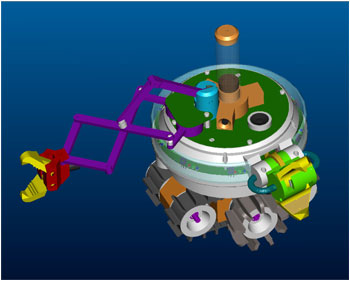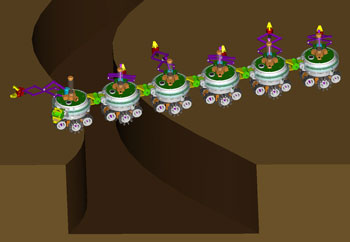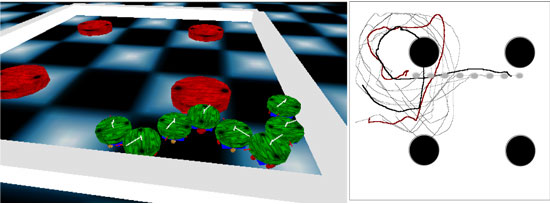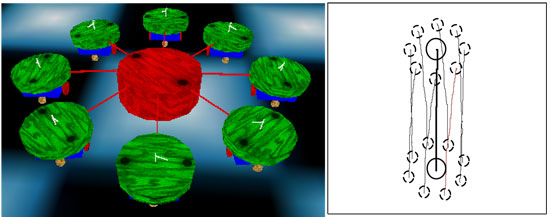
This issue in pdf Archive: Next issue: Next Special theme: |
|
|||||||||
Swarm-Bots: Swarm of Mobile Robots able to Self-Assemble and Self-Organizeby Stefano Nolfi, Jean-Louis Denebourg, Dario Floreano, Luca Gambardella, Francesco Mondada and Marco Dorigo Swarm-bots are a collection of mobile robots able to self-assemble and to self-organize in order to solve problems that cannot be solved by a single robot. These robots combine the power of swarm intelligence with the flexibility of self-reconfiguration as aggregate swarm-bots can dynamically change their structure to match environmental variations. SWARM-BOTS, a project funded by the Future and Emerging Technologies program of the European Community (project IST-2000-31010), focuses on the design and the implementation of self-organising and self-assembling biologically-inspired robots. The project benefits from the joint activity of four European research institutes: the Artificial Intelligence Laboratory of the Université Libre de Bruxelles (IRIDIA); Dalle Molle Institute of Artificial Intelligence Studies of Lugano (IDSIA); the Autonomous Systems Laboratory of the Swiss Federal Institute of Technology (ASL-EPFL), and the Institute of Cognitive Sciences and Technology of the Italian National Research Council (ISTC-CNR). A swarm-bot is an aggregate of s-bots (mobile robots able to self-assemble by connecting/disconnecting from each other) that can explore, navigate and transport heavy objects on rough terrains in situations in which a single s-bot would have major problems to achieve the task alone (see Figures 1 and 2). Each s-bot has simple sensors and motors, limited computational capabilities, and physical links that allow it to connect to other s-bots. The swarm-bot should move as a whole and reconfigure along the way when needed. For example, it might adopt a different shape in order to go through a narrow passage or overcome an obstacle. An aggregate should form as a result of self-organizing rules followed by each individual s-bot rather than via a global template. Thus swarm-bots combine the power of swarm intelligence, as they are based on the emergent collective intelligence of groups of robots, and the flexibility of self-reconfiguration as aggregate swarm-bots can dynamically change their structure to match environmental variations.
We have now completed the hardware design (the first hardware prototypes will be ready within the next few weeks). As shown in Figure 1, each s-bot has a cylindrical body with a diameter of 116mm and consists of a mobile base provided with two differential drive mechanisms controlling tracks and wheels, and a main body with two grippers that allow it to assemble with other s-bots or to grasp objects. The first gripper is supported by a mobile structure that can rotate around a horizontal axis and the second gripper is supported by a motorized arm that allows large movements through the vertical and horizontal axes. The main body rotates with respect to the base supporting the tracks. From the sensory point of view, each s-bot has proximity sensors, light sensors, accelerometers, humidity sensors, sound sensors, an omni-directional color camera, light barrier sensors (on the grippers), force sensors etc.
We are following two different but complementary research directions in order to develop the control systems of a swarm-bot. One consists in building control systems that mimic the characteristics of biological systems such as social insects. The other consists in building control systems that are only loosely inspired by what we know about real organisms and develop their ability through a self-organization process based on artificial evolution. By following the first approach, we have been able to develop, for example, the control systems of a group of simple LEGOTM robots that are able to aggregate into chain formations. By following the latter, we were able to develop simulated s-bots displaying coordinated movements, collective obstacle avoidance, and object pushing/pulling (see Figures 3 and 4).
Figure 3 shows a swarm-bot displaying collective obstacle avoidance. On the left, we have eight simulated s-bots assembled into a snake-like formation placed in an arena surrounded by walls with four cylindrical obstacles. On the right, we see the trajectory produced by the swarm-bots that move in the arena. The small gray circles represent the initial position and shape of the swarm-bots. The square and the large full circles represent the walls and the obstacles. The lines show the trajectory of the s-bots. As can be seen, the swarm-bot is able to avoid obstacles and pass narrow passages eventually deforming its shape according to the configuration of the obstacles. Figure 4 shows a swarm-bot displaying object pushing/pulling. The swarm-bot consists of 8 s-bots connected to an object. On the right can be seen traces made by the s-bots (thin lines) and the object (bold line) during a few seconds. Large and small dotted circles represent the initial (bottom) and final (top) positions of the object and of the s-bot, respectively. Potential applications of this novel type of robot are, for instance, semi-automatic space exploration, rescue searches or underwater exploration. Links: Please contact: |
|||||||||





